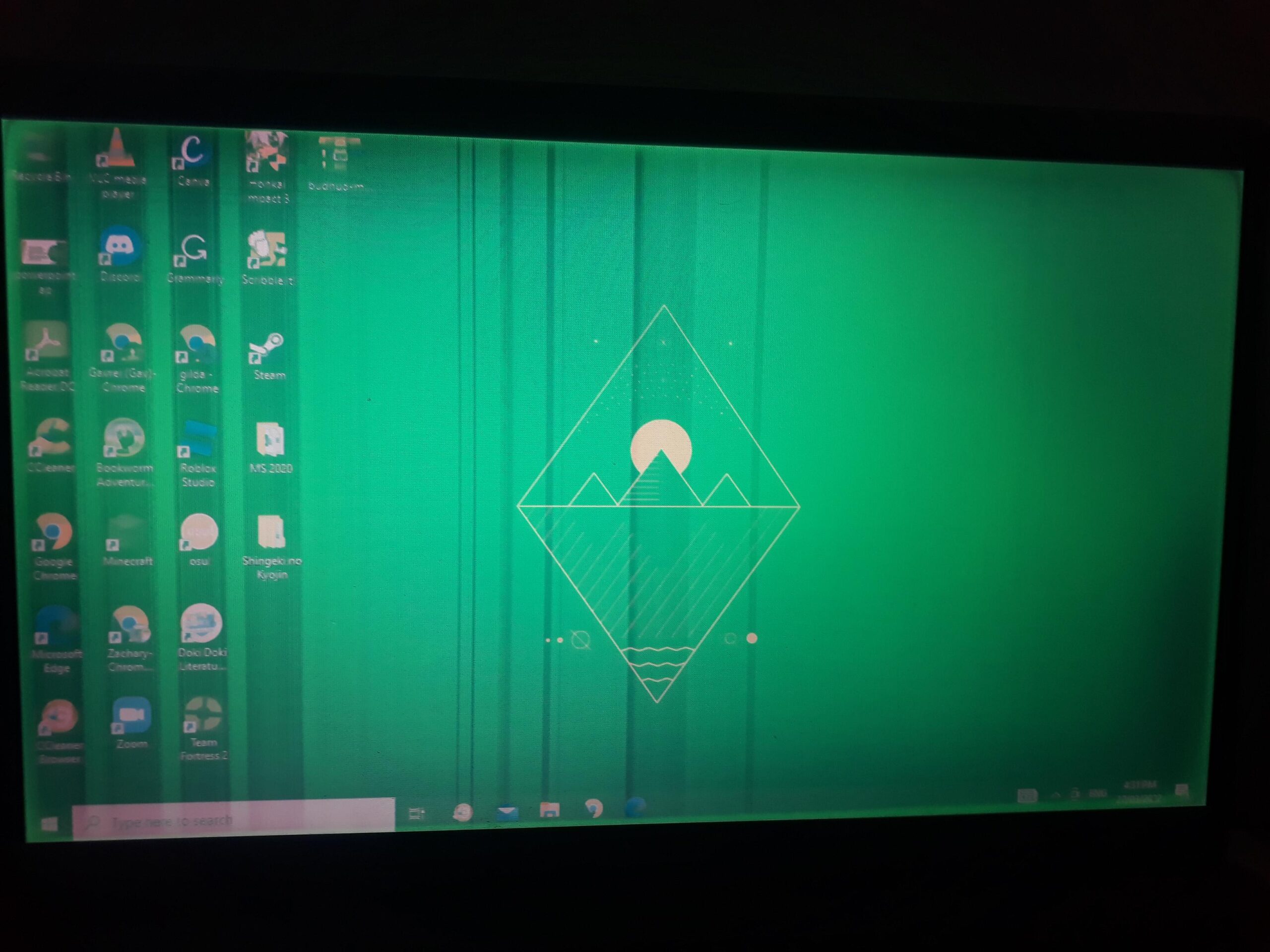Your laptop screen may appear green due to a loose or damaged display cable. Checking and replacing the cable can resolve this issue.
Experiencing a green tint on your laptop screen can be frustrating and disruptive to your work or leisure activities. Understanding the possible reasons behind this problem can help you troubleshoot and fix it effectively. We will explore common causes of a green laptop screen, practical steps to diagnose the issue, and potential solutions to rectify it.
By following these guidelines, you can gain a better understanding of why your laptop screen is green and take the necessary steps to resolve this technical glitch promptly. Let’s delve into the details to get your laptop display back to normal.

Credit: superuser.com
Common Laptop Screen Issues
A laptop is an indispensable tool for work, study, and entertainment, but it may encounter various screen problems. Here are some common issues you might face with your laptop screen:
Blurry Or Fuzzy Display
A blurry or fuzzy display can be quite frustrating and might result from outdated display drivers or hardware issues. Adjusting the screen resolution and updating the graphics drivers can often resolve this problem.
Screen Flickering
Screen flickering is a common issue that can be caused by a loose or damaged cable, outdated drivers, or incompatible applications. Ensuring that the drivers and operating system are up to date, as well as checking for software conflicts, can help alleviate this problem.
Screen Freezing
Screen freezing can occur due to an overworked CPU, insufficient memory, or a failing hard drive. Regularly maintaining your laptop by closing unnecessary programs and running disk cleanup can help prevent screen freezing issues.
Color Distortion
Color distortion on the laptop screen may stem from a loose or damaged cable, faulty graphics card, or outdated drivers. Confirming that the cables are securely connected and updating the graphics drivers can often resolve this issue.
Understanding The Green Screen Problem
A green screen on your laptop can be frustrating and disruptive, impacting your work or leisure activities. It is essential to diagnose the root cause of this issue to resolve it effectively.
Causes Of A Green Screen
- Loose cable connections can trigger a green screen.
- Graphics card driver issues may lead to screen discoloration.
- Hardware malfunctions, such as a faulty GPU, are potential causes.
Potential Hardware Issues
- Monitor cable or port defects might result in a green screen.
- Graphics processing unit (GPU) failure can lead to screen color problems.
- Overheating issues may cause the screen to display a green tint.
Software-related Problems
- Outdated graphics drivers can cause compatibility issues.
- Software conflicts, such as incompatible applications, might trigger the green screen.
- Operating system glitches could be contributing to the screen displaying a green hue.
Identifying whether the green screen issue is hardware or software-related is crucial for implementing the right fix.
Troubleshooting Steps
Experiencing a green laptop screen could signal a graphics card issue. Troubleshoot by updating drivers, adjusting display settings, or checking hardware connections. Consult a technician if problems persist.
Adjusting Display Settings
To adjust display settings, follow these simple steps:
- Right-click on your desktop and select Display Settings
- Check the Color Calibration and Resolution settings
Updating Graphics Drivers
Keep your graphics drivers up to date by:
- Visiting the manufacturer’s website for the latest drivers
- Downloading and installing the updated drivers
Checking Hardware Connections
- Inspecting the cable connections from the laptop to the monitor
- Reconnecting any loose cables or adapters
Resolving Green Screen With Software Fixes
If you are experiencing a green screen on your laptop, it can be caused by various software issues which can be resolved without hardware intervention. Here are some effective software fixes that can help you get rid of the green screen problem.
Running Antivirus Scans
Viruses and malware can affect your system’s display settings and cause the screen to turn green. Running a thorough antivirus scan can help identify and remove any malicious software that might be causing this issue.
Disabling Graphic Effects
Graphic effects and settings can sometimes interfere with your display, leading to the green screen problem. Disabling unnecessary graphic effects and adjusting display settings can potentially resolve this issue.
Resetting Color Calibration
Incorrect color calibration can result in an abnormal display output, including a green-tinted screen. Resetting the color calibration to default settings can help rectify this problem.
Fixing Green Screen By Resetting Graphics Settings
If your laptop screen has a green tint, it could be due to graphics settings. Resetting the graphics settings can often resolve this issue, as it may be a result of a software glitch. It’s a quick and simple fix that can make your screen look as good as new.
Accessing Graphics Control Panel
One of the common causes of a green screen on your laptop is an issue with the graphics settings. Luckily, you can easily fix this problem by resetting the graphics settings. To start, you need to access the graphics control panel on your laptop.
To access the graphics control panel, simply follow these steps:
- Right-click anywhere on your desktop to open a context menu.
- From the context menu, select the “Graphics Properties” or “Graphics Options” option.
- This will open the graphics control panel, which allows you to make changes to the display settings.
Resetting Color Profile
Once you have accessed the graphics control panel, the next step is to reset the color profile. This can help resolve the green screen issue on your laptop.
To reset the color profile, follow these steps:
- In the graphics control panel, navigate to the “Color” or “Color Management” section.
- Look for an option to reset the color profile or restore default settings.
- Click on this option to reset the color profile to its default settings.
- After resetting the color profile, restart your laptop to apply the changes.
Restoring Default Display Settings
If resetting the color profile didn’t fix the green screen issue, you can try restoring the default display settings. This will revert any changes you made to the display settings and can help resolve the problem.
To restore the default display settings, follow these steps:
- In the graphics control panel, navigate to the “Display” or “Display Settings” section.
- Look for an option to restore default display settings.
- Select this option to restore the display settings to their default values.
- Restart your laptop to apply the changes and see if the green screen issue is resolved.
Dealing With Graphics Hardware Issues
If you are experiencing a green tint on your laptop screen, there is a high possibility that the issue lies with your graphics hardware. This can be a frustrating problem to deal with, especially if you rely on your laptop for work or entertainment. To help you troubleshoot and resolve this issue, we have outlined a few steps you can take to address possible graphics hardware problems.
Checking Gpu Temperature
One potential cause of a green screen is an overheating graphics processing unit (GPU). When the GPU gets too hot, it can affect the display quality of your laptop screen. To check the temperature of your GPU, you can use various software tools, such as GPU-Z or HWMonitor. These programs provide real-time temperature readings, allowing you to monitor the heat levels of your GPU. If you notice that the temperature is consistently high, it may be necessary to take steps to cool down your graphics card.
Cleaning Graphics Card
Dust and debris can accumulate on your graphics card over time, impairing its performance and causing display issues. Cleaning your graphics card can help improve its cooling efficiency and prevent overheating. Before cleaning, make sure to turn off your laptop and disconnect it from the power source. Use compressed air or a soft-bristled brush to gently remove any dust from the graphics card and its fans. Be careful not to apply too much pressure or use liquid cleaners, as this can damage the delicate components. A clean graphics card will improve airflow and potentially resolve the green screen problem.
Replacing Faulty Components
If you have checked the GPU temperature and cleaned your graphics card but the green screen issue persists, you may need to consider replacing faulty hardware components. Over time, graphics cards can become damaged or outdated, leading to display problems. To determine if your graphics card is the culprit, you can try connecting an external monitor to your laptop. If the external monitor displays colors correctly, it is likely that your laptop’s built-in screen or graphics card is causing the green tint. In this case, you may need to consult a professional technician to replace the faulty components.
By taking these steps to address graphics hardware issues, you can troubleshoot and resolve the green screen problem on your laptop. Remember to check the GPU temperature, clean your graphics card, and consider replacing faulty components if necessary. With these measures in place, you can once again enjoy vibrant and accurate colors on your laptop screen.
Contacting Technical Support
If you are seeing a green tint on your laptop screen, it’s crucial to reach out to technical support for assistance. Here are the steps to take when contacting technical support:
Reaching Out To Laptop Manufacturer
Contacting the laptop manufacturer can be beneficial in troubleshooting the green screen issue. Look for the manufacturer’s support contact information on their official website or the laptop’s documentation. Be prepared to provide the make, model, and serial number of your laptop when reaching out to them. Often, the manufacturer’s technical support team can guide you through troubleshooting steps and provide recommendations for resolving the green screen problem.
Consulting A Professional Technician
If reaching out to the laptop manufacturer doesn’t fully address the green screen issue, consulting a professional technician may be necessary. Search for reputable computer repair shops or technicians with experience in laptop screen repairs. A professional technician can diagnose the underlying cause of the green screen and determine if any hardware components need to be replaced or repaired. They can also provide expert guidance on resolving the issue, ensuring your laptop screen displays colors accurately once again.

Credit: answers.microsoft.com
Preventive Measures To Avoid Green Screen
- Regularly clean vents to prevent dust buildup.
- Avoid using the laptop on soft surfaces that block airflow.
- Ensure the laptop is placed on a flat, hard surface.
- Close unnecessary applications to reduce strain on the system.
- Update drivers and software from official sources.
- Avoid downloading drivers from unreliable sources.

Credit: www.reddit.com
Frequently Asked Questions Of Why Is My Laptop Screen Green
Q: Why Is My Laptop Screen Green?
A: A green laptop screen can be caused by various factors, such as a loose or damaged cable connection, driver issues, or a malfunctioning graphics card. Try reconnecting the display cable, updating the graphics driver, or contacting a technician for further assistance.
Q: What Causes A Green Tint On A Laptop Screen?
A: The green tint on a laptop screen can be caused by a faulty color profile, incorrect display settings, or a failing graphics card. Adjusting the color settings, calibrating the display, or updating the graphics driver may help resolve the issue.
Q: How Can I Fix A Green Laptop Screen?
A: To fix a green laptop screen, start by adjusting the color settings in the display settings menu. If that doesn’t work, try recalibrating the display or updating the graphics driver. If the problem persists, consider contacting a professional technician for further diagnosis and repair.
Conclusion
Dealing with a green laptop screen can be frustrating, but there are several potential causes and solutions to explore. By understanding the common reasons behind this issue, you can troubleshoot and fix it effectively. Whether it’s a software glitch, a hardware problem, or a driver issue, taking the right steps can help you resolve the green screen problem and get your laptop back to normal.


0 comments